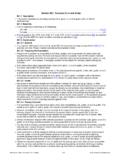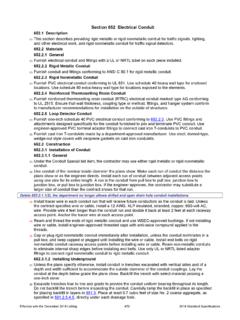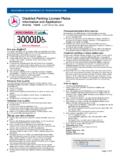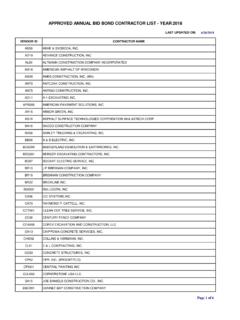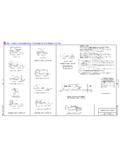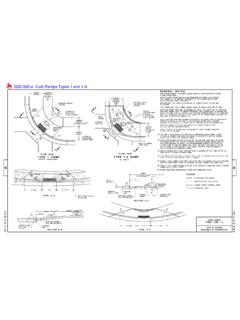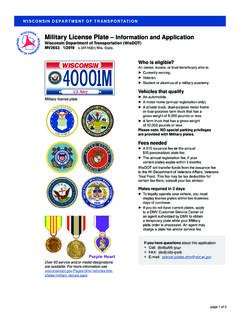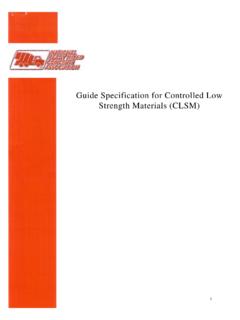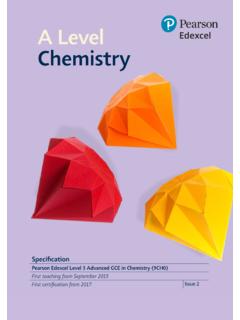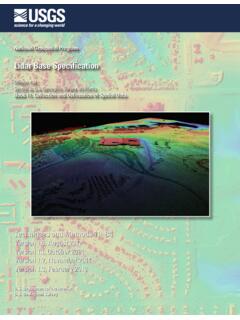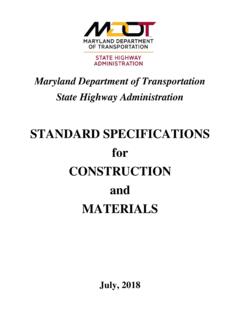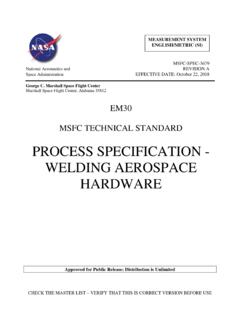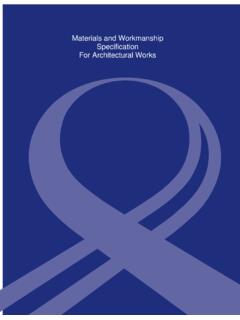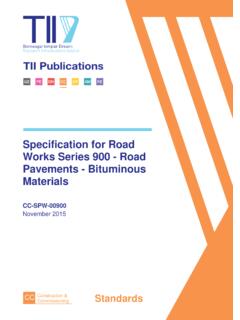Transcription of SPECIFICATION P–208. AGGREGATE BASE COURSE
1 P-208 SPECIFICATION P 208. AGGREGATE base COURSEDESCRIPTION208 This Work consists of a base COURSE composed of hard, durable particles or fragments of crushed coarse AGGREGATE blended with eitherbinder and fine AGGREGATE or filler. Construct it on a prepared underlying COURSE in accordance with these Specifications and in conformancewith the dimensions and typical cross section shown on the AGGREGATE . Aggregates consist of both fine and coarse fragments of crushed stone, or crushed gravel mixed or blended withsand, screenings, or other similar approved materials. Crushed stone consists of hard, durable particles or fragments of crushed gravel consists of hard, durable stones, rock, and boulders crushed to specified size. Produce AGGREGATE free from excess flat,elongated, soft or disintegrated pieces, dirt, or other objectionable matter.
2 The method used in production of crushed gravel shall be such thatthe fractured particles occurring in the finished product shall be constant and uniform and shall result in at least 45 percent of material retainedon a No. 4 mesh ( mm) sieve having one or more fractured faces. If necessary to meet this requirement or to eliminate an excess of fine,uncrushed particles, screen the gravel before crushing. Stones, rocks, and boulders of inferior quality in the pit shall be coarse AGGREGATE shall not have more than 50 percent wear at 500 revolutions as determined by ASTM C 131. When the fraction of theaggregates retained on the No. 4 mesh ( mm) sieve is subjected to five cycles of the sodium sulfate soundness test (ASTM C 88), theweighted loss shall not exceed 18 percent by weight, unless otherwise provided in the material passing the No.
3 4 mesh ( mm) sieve produced in the crushing operation of either stone or gravel in the base material tothe extent permitted by the gradation requirements. Oversized stones, rocks and boulders occurring in the pit or quarry material shall be wasted;those of acceptable quality may be crushed and become a part of the base material, provided the blend meets the specified gradations. Theaggregate shall be free from vegetation, lumps, or excessive amounts of clay and other objectionable SAMPLING AND TESTING. Furnish aggregates for preliminary testing prior to the start of production. The Engineer will test forinitial AGGREGATE submittals necessary to determine compliance with the SPECIFICATION requirements at no expense to the samples of aggregates at the start of production and at intervals during production.
4 The Engineer will designate sampling points andintervals. The samples will be the basis of approval of specific lots of aggregates from the standpoint of the quality requirements of of testing, the Engineer may accept certified State of Wisconsin Department of Transportation test results indicating that the aggregatemeets SPECIFICATION Engineer may take samples of aggregates to check gradation periodically during construction. Sampling will be in accordance with ASTMD 75, and testing will be in accordance with ASTM C 136 and C TO SPECIFIER:The intent of this SPECIFICATION is to provide an airport SPECIFICATION for base COURSE withrequirements similar to Highways Section 304. The resulting material should be superior to theoriginal P 208 material. Use this SPECIFICATION on pavements with gross weights less than 60,000pounds.
5 When designing pavement thickness, consider using an equivalency factor to increase thethickness of P 208 GRADATION. The gradation shall meet the requirements of one of the gradations given in Table 1 when tested in accordance withASTM C 117 and C 1. REQUIREMENTS FOR GRADATION OF AGGREGATES ieve SizePercentage by Weight PassingGradation No. 1 Gradation No. 2 Gradation No. 3 CrushedGravelCrushedStoneCrushedGravelCr ushedStoneCrushedGravelCrushedStone1 1/2 Inch ( mm)1 Inch ( mm)3/4 Inch ( mm)3/8 Inch ( mm)No. 4 ( mm)No. 10 ( mm)No. 40 ( mm)No. 200 ( mm)10075 100 40 7530 6020 4510 303 10100 30 6525 5515 40 2 12 100 50 8535 6525 5010 303 10 100 40 7525 6015 45 3 12 10095 10050 9035 7020 5510 358 15 10095 10050 9035 7015 55 5 15 The gradations in the table represent the limits that shall determine suitability of AGGREGATE for use from the sources of supply.
6 The finalgradations decided within the limits designated in the table shall be well graded from coarse to fine and shall not vary from the low limit on onesieve to the high limit on the adjacent sieves, or vice amount of the fraction of material passing the No. 200 mesh ( mm) sieve shall not exceed one half the fraction passing the No. 40mesh ( mm) portion of the filler and binder, including blended material, passing the No. 40 mesh ( mm) sieve shall have a liquid limit not more than25 and a plasticity index not more than 6 when tested in accordance with ASTM D of gradations shown in the table shall be such that the maximum size AGGREGATE used in any COURSE shall be not more than two thirdsthe thickness of the layer of the COURSE being FILLER FOR BLENDING If filler, in addition to that naturally present in the base COURSE material, is necessary for satisfactorybonding of the material, for changing the soil constants of the material passing the No.
7 40 mesh ( mm) sieve, or for correcting the gradationto the limitations of the specified gradation, it should be uniformly blended with the base COURSE material at the crushing plant or at the mixingplant. The material for this shall be obtained from Engineer approved sources and shall be of a gradation necessary to accomplish the specifiedgradation in the finally processed additional filler may be composed of sand, but the amount of sand shall not exceed 20 percent by weight of the total combined baseaggregate. All the sand shall pass a No. 4 mesh ( mm) sieve and not more than 5 percent by weight shall pass a No. 200 mesh ( mm) METHODS208 OPERATIONS IN PITS AND QUARRIES. Perform Work involved in clearing and stripping pits and quarries, including handlingof unsuitable material. Handle material in a manner to construct a uniform and satisfactory base COURSE .
8 Obtain base COURSE material fromapproved PREPARING UNDERLYING COURSE . The underlying COURSE will be checked and accepted by the Engineer before placing andspreading operations are started. Correct ruts or soft, yielding places due to improper drainage conditions, hauling, or other causes, and roll theunderlying COURSE to the required density before the base COURSE is placed protect the underlying COURSE and to ensure proper drainage, begin spreading the base along the centerline of the pavement on a crownedsection or on the high side of the pavement with a one way MIXING. Uniformly blend the AGGREGATE during crushing operations or mix in a plant. The plant shall blend and mix the materials tomeet the specifications and to secure the proper moisture content for PLACING. Place AGGREGATE base material on the prepared underlying COURSE and compact in layers of the thickness shown on thePlans.
9 Deposit and spread the material where designated and progress continuously without breaks. Deposit and spread material in lanes in auniform layer and without segregation of size to a loose depth that, when compacted, the layer shall have the required thickness. Spread baseaggregate on a moistened subgrade, in layers of uniform thickness. Dumping from vehicles in piles that require rehandling shall not bepermitted. Hauling over the uncompacted base COURSE is not base COURSE in layers not less than 3 inches (75 mm) nor more than 6 inches (150 mm) compacted thickness. AGGREGATE , in place,shall meet gradation specifications. Do not spread more than 2,000 square yards (1,700 square meters) in advance of the rolling. Do not placematerial in snow or on a soft, muddy, or frozen more than one layer is required, the construction procedure described applies similarly to each caution during the mixing and spreading process to prevent the incorporation of subgrade, subbase, or shoulder material in the basecourse COMPACTION.
10 Compact AGGREGATE immediately upon completion of the spreading operations. Use a sufficient number, type, andweight of rollers to compact the material to the required density. Compact the AGGREGATE base COURSE in-place to a field target density of at least100 percent and a lower SPECIFICATION limit (L) of at least percent of the maximum density of laboratory specimens prepared from samplesof base COURSE material delivered to the job moisture content of the material during placing operations shall not be below, nor more than 1 1/2 percentage points above, the optimummoisture content as determined by ASTM D 698, unless it can be demonstrated in the field that the maximum density can be achieved at lowermoisture TO SPECIFIER:For gross aircraft weights greater than 60,000 pounds, revise the ASTM reference in thepreceding paragraph, by Special Provision, to required use of ASTM D ACCEPTANCE SAMPLING AND TESTING FOR DENSITY.
